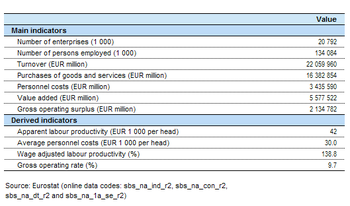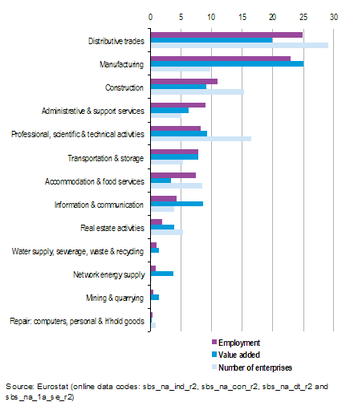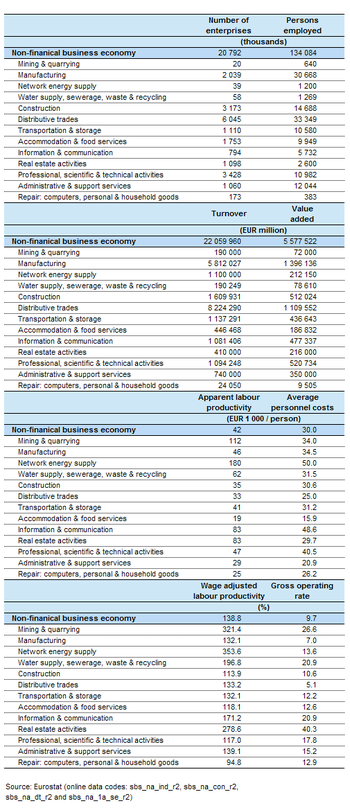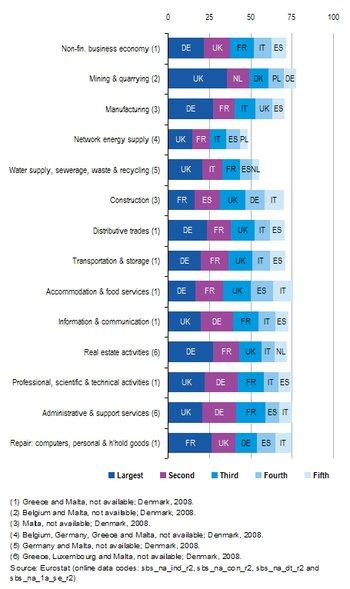Archive:Business economy - structural profile
Data from April 2012. Most recent data: Further Eurostat information, Main tables and Database

Source: Eurostat (sbs_na_ind_r2), (sbs_na_con_r2), (sbs_na_dt_r2), (sbs_na_1a_se_r2)

Source: Eurostat (sbs_na_ind_r2), (sbs_na_con_r2), (sbs_na_dt_r2), (sbs_na_1a_se_r2)

Source: Eurostat (sbs_na_ind_r2), (sbs_na_con_r2), (sbs_na_dt_r2), (sbs_na_1a_se_r2)

Source: Eurostat (sbs_na_ind_r2), (sbs_na_con_r2), (sbs_na_dt_r2), (sbs_na_1a_se_r2)

Source: Eurostat (sbs_na_ind_r2), (sbs_na_con_r2), (sbs_na_dt_r2), (sbs_na_1a_se_r2)

Source: Eurostat (sbs_sc_ind_r2), (sbs_sc_con_r2), (sbs_sc_dt_r2), (sbs_sc_1b_se_r2)

Source: Eurostat (sbs_sc_ind_r2), (sbs_sc_con_r2), (sbs_sc_dt_r2), (sbs_sc_1b_se_r2)

Source: Eurostat (sbs_sc_ind_r2), (sbs_sc_con_r2), (sbs_sc_dt_r2), (sbs_sc_1b_se_r2)

Source: Eurostat (sbs_sc_ind_r2), (sbs_sc_con_r2), (sbs_sc_dt_r2), (sbs_sc_1b_se_r2)
This article focuses on the non-financial business economy and belongs to a set of statistical articles which analyse the structure and characteristics of the economic activities within the non-financial business economy of the European Union (EU).
Main statistical findings
Size and structure of the non-financial business economy
In 2009 a total of EUR 5 577 522 million of gross value added was generated in the EU-27’s non-financial business economy and the non-financial business economy workforce reached 134.1 million persons employed.
The sectors that make up the non-financial business economy are shown in Figure 1 which provides an overview of their contribution in terms of labour input (employment), output (value added), and the enterprise population. In broad terms, manufacturing and distributive trades were the largest sectors, combining for 45 % or more of the value added and employment total.
Apparent labour productivity averaged EUR 41.6 thousand per person employed in the EU-27’s non-financial business economy in 2009, ranging from EUR 19 thousand per person employed in accommodation and food services to EUR 180 thousand per person employed in network energy supply. Average personnel costs were also lowest in the accommodation and food services sector (EUR 15.9 thousand per employee) and highest in network energy supply (EUR 50.0 thousand per employee); the non-financial business economy average was EUR 30.0 thousand per employee. It should be noted that both of these indicators are based on a simple head count of employment and so are influenced, at least in part, by the extent of part-time employment. The influence of part-time employment is largely removed by combining these two measures into the wage adjusted labour productivity ratio: for the non-financial business economy this ratio was valued at 138.8 % in 2009, indicating that average labour productivity was 38.8 % higher than average personnel costs. This indicator was below 100 % for the small sector of repair of computers, personal and household goods and rose above 300 % for the network energy supply sector and the mining and quarrying sector.
As can be seen from Figure 2, a Member State’s share of the EU-27’s non-financial business economy varies substantially depending whether it is measured in terms of value added or employment. Those with higher shares of EU-27 value added than the workforce (such as Germany, the United Kingdom and France) had above average apparent labour productivity.
National specialisation and concentration
The share of the five largest Member States in the EU-27’s value added gives an impression of geographical concentration; the average share for the non-financial business economy was 71.5 % in 2009. An analysis at the level of detail shown in Figure 3 indicates that the highest concentration was for mining and quarrying and the lowest for construction and distributive trades; network energy supply had a lower level of concentration by this measure, but it should be noted that German data is not available for this sector, thus strongly influencing the results. Generally, in each sector the five largest Member States were the five Member States with the largest overall economies, with the mining and quarrying sector the main exception.
The most specialised Member State in an activity is the one where that activity’s share of the non-financial business economy is highest, regardless of whether the Member State is large or small. In contrast to concentration measures that typically highlight the largest Member States, measures of specialisation often identify smaller or medium-sized Member States. In only two of the activities presented in Tables 4 or 5 were large Member States the most specialised Member State; in both cases this concerned specialisation in value added terms for services activities, once each for France and the United Kingdom. Some specialisations are due to the availability of natural resources, for example specialisation in mining and quarrying in Denmark and Poland.
Table 6 shows the activity in which each Member State is most specialised, relative to the EU-27 as a whole - this is based on value added shares in the non-financial business economy. For just over half of the Member States the activity in which they sere most specialised was an industrial activity. Spain and Portugal were relatively most specialised in construction, Cyprus and Austria in accommodation and food services, and Germany, Finland and Sweden in real estate activities. Belgium was most specialised in administrative and support services, France in the repair of computers, personal and household goods, Latvia in transportation and storage and Luxembourg in professional, scientific and technical activities. It should be noted that some activities are relatively small across the whole of the EU, which means that even in a Member State with a high specialisation relative to the EU-27 average this activity may in fact only contribute a small proportion of non-financial business economy value added, as is the case for France. None of the Member States were most specialised in water supply, sewerage, waste and recycling, nor in distributive trades, nor information and communication services.
Data sources and availability
Structural business statistics are compiled under the legal basis provided by European Parliament and Council Regulation 295/2008 on structural business statistics, and in accordance with the definitions, breakdowns (level of analysis), deadlines for data delivery, and various quality aspects specified in the regulations implementing it.
Eurostat’s structural business statistics describe the structure, conduct and performance of economic activities, down to the most detailed activity level (several hundred sectors).
Structural business statistics cover the ’business economy’, which includes industry, construction and many services (NACE Rev. 2 Sections B to N and Division 95); financial and insurance activities (NACE Section K) are treated separately within structural business statistics because of their specific nature and the limited availability of most types of standard business statistics in this area. As such, the term ’non-financial business economy’ is generally used in business statistics to refer to those economic activities covered by NACE Rev. 2 Sections B to J and L to N and Division 95 and the units that carry out those activities. Structural business statistics do not cover agriculture, forestry and fishing, nor public administration and (largely) non-market services, such as education or health.
Structural business statistics contain a comprehensive set of basic variables describing business demographics and employment characteristics, as well as monetary variables (mainly concerning operating income and expenditure, or investment). In addition, a set of derived indicators has been compiled: for example, ratios of monetary characteristics or per head values.
Context
In October 2010 the European Commission presented a Communication on a renewed industrial policy. ‘An industrial policy for the globalisation era’ provides a blueprint that puts industrial competitiveness and sustainability centre stage. It is a flagship initiative that forms part of the Europe 2020 strategy, and sets out a strategy that aims to boost growth and jobs by maintaining and supporting a strong, diversified and competitive industrial base in Europe offering well-paid jobs while becoming less carbon intensive. The initiative establishes a strategic agenda and proposes some broad cross-sectoral measures, as well as tailor-made actions for specific industries, mainly targeting the so-called ‘green innovation’ performance of these sectors.
The internal market remains one of the EU’s most important priorities. The central principles governing the internal market for services were set out in the EC Treaty. This guarantees EU enterprises the freedom to establish themselves in other Member States and the freedom to provide services on the territory of another EU Member State other than the one in which they are established. The objective of the Services Directive 2006/123/EC of 12 December 2006, on services in the internal market, is to eliminate obstacles to trade in services, thus allowing the development of cross-border operations. It is intended to improve competitiveness, not just of service enterprises but also of European industry as a whole. In December 2006, this Directive was adopted by the European Parliament and the Council with transposition by the Member States required by the end of 2009. It is hoped that the Directive will help achieve potential economic growth and job creation. By providing for administrative simplification, it also supports the better regulation agenda.
Further Eurostat information
Publications
Main tables
Database
- SBS - main indicators (sbs_na)
- SBS - industry and construction (sbs_ind_co)
- SBS - trade (sbs_dt)
- SBS - services (serv)
Dedicated section
Other information
- Regulation 58/1997 of 20 December 1996 concerning structural business statistics
- Decision 2367/2002/EC of 16 December 2002 on the Community statistical programme 2003 to 2007
- Regulation 295/2008 of 11 March 2008 concerning structural business statistics
Source data for tables and figures (MS Excel)
See also
Structural business statistics introduced
More detailed analysis of the non-financial business economy:
- Mining and quarrying
- Manufacturing
- Electricity, gas, steam and air conditioning supply / network energy supply
- Water supply; sewerage, waste management and remediation activities
- Construction
- Distributive trades
- Transportation and storage
- Accommodation and food service activities
- Information and communication services
- Real estate activities
- Professional, scientific and technical activities
- Administrative and support service activities
- Repair of computers and personal and household goods
Other analyses of the business economy by NACE Rev. 2 sector